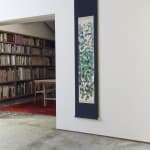Omoda Seiju (1891–1933)
Persimmons
Color on paper, hanging scroll
With a Tokyo Art Club certificate, box authentication by Hayami Gyoshu
Seal: Seiju
134 x 28 cm
216 x 42 cm (overall)
Further images
The work In a Greenhouse (Fukushima Prefectural Museum of Art) by Omoda Seiju is a four-panel folding screen depicting a greenhouse filled with brightly colored and distinctive flowers in full bloom, including sobralia, anthurium, Panama hat palm, episcia, shell ginger, and others that extend over the entire surface of the screen. Exhibited at the fourteenth revival Inten exhibition held at the Tokyo Prefectural Art Museum from September 3 to October 4, 1927, it signaled a turning point in the artist’s style. The various flowers in their gorgeous array of colors are depicted not in accordance with a sense of perspective based on the true nature of the scene, but instead they deliberately create a type of formalistic beauty through the use of this two-dimensional composition. The current work, which, judging from the characteristics of the signature would seem to have been produced in around the same period, presents a similar lightness of presence and harmony of colors with its heavily drooping persimmon fruit as its subject. It is unclear exactly where the trunk of the persimmon tree ends and where the branches begin as they extend outward, but by cropping out a section of the large persimmon tree in this long, vertical format, the artist would seem to be vividly depicting the fruits that are symbolically growing over the whole tree and the sense of the autumn season that underlies them. The unpainted areas of the paper left showing through between the branches can, on the contrary, be taken in various different ways depending on the viewer, potentially appearing either as blue sky breaking through the leaves, or as an overcast cloudy sky transitioning indistinctly between heavens and earth. The box inscription by Hayami Gyoshu from the year following Seiju’s death is also precious.
Omoda Seiju (nihonga painter; 1891–1933)
Saitama-born nihonga painter. His real name is Mokichi. Left for Tokyo to study at Matsumoto Fuko’s private school, Angado gajuku. Later joined Imamura Shiko and others in the founding of Sekiyo-kai. After the breakup of Sekiyo-kai, continued to be active as a Meguro School member at Inten. Excelled at landscape and bird-and-flower paintings, and created his characteristic world of fantasy and decorativeness. Known for his Scroll of Insects and Fishes. A member of Inten.
Omoda Seiju (nihonga painter; 1891–1933)
Saitama-born nihonga painter. His real name is Mokichi. Left for Tokyo to study at Matsumoto Fuko’s private school, Angado gajuku. Later joined Imamura Shiko and others in the founding of Sekiyo-kai. After the breakup of Sekiyo-kai, continued to be active as a Meguro School member at Inten. Excelled at landscape and bird-and-flower paintings, and created his characteristic world of fantasy and decorativeness. Known for his Scroll of Insects and Fishes. A member of Inten.









